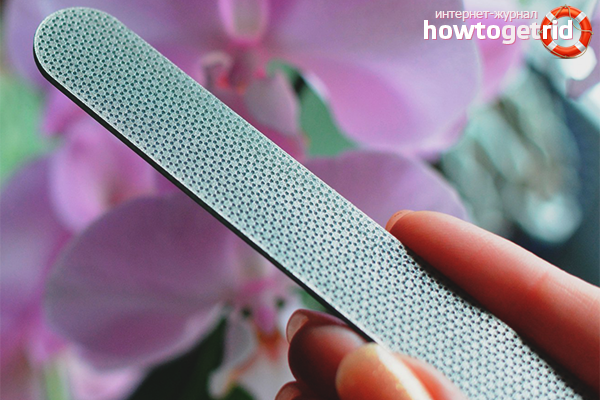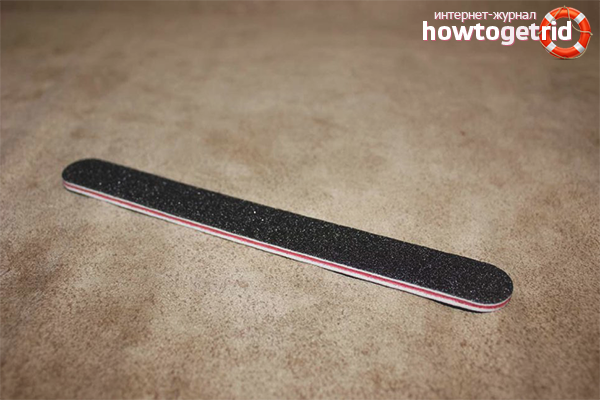A nail file is rightfully considered an integral attribute of a manicure set. The tool allows you to align the free edge of the nail plate and give it shape. A low-quality device can also cause harm. For this reason, many girls wonder how to choose the right nail file. Tools vary in material, abrasiveness (degree of hardness), and pricing policy. Let's look at the main features and provide practical advice.
Glass nail file
- The glass file is considered the most durable, easy to use, and gentle. The cost of the device is relatively low, which makes it possible for girls with average incomes to purchase it.
- Glass files come in different lengths, thicknesses and degrees of abrasiveness (hardness of the working surface). They prevent delamination, carefully file and seal the free edge.
- The service life of the tool reaches up to a year of daily use. During use, the coating wears off, indicating that it is time to replace the file.
- Its universal properties allow you to sharpen fingernails and toenails, as well as work with artificial turf. Some ladies resort to using a glass file when they want to polish the surface of a plate.
- The main disadvantage of glass devices is considered to be elementary fragility. If the file falls on the floor or is pressed by other manicure tools, the glass will break. The hard case that comes with the kit helps prevent this from happening.
Ceramic nail file
- The device is of high quality due to ceramic coating. Due to the optimal degree of abrasiveness, this type of file is used on thin and weakened nails (after extension or shellac procedures).
- A ceramic file is a professional tool. Manicure cutters are made on the basis of this material. In addition to effective filing, the device seals the free edge.
- If we talk about the pricing policy, it is quite high. You won't overpay because the tool is durable. If used correctly, it will last more than a year.
- Some types of files are suitable for removing cuticles. However, without proper skill, the procedure should be carried out with extreme caution. As a result, you will get two tools in one for an affordable price.

- Masters of the nail industry call such nail files laser. The tool appeared on sale relatively recently and literally exploded the market.
- Diamond files allow you to process the free edge of the nail plate in all directions. Most other types cannot boast of this feature.
- Due to its texture and diamond coating, the device does not injure the nails by sealing the tip. After two weeks of use, you can notice the cessation of delamination.
- The laser file belongs to the professional segment; it is used by masters when working with natural or artificial nails.
- A negative characteristic is the high pricing policy. The cost of the tool is almost 10 times higher than that of paper files.
Metal nail file
- Files of this kind cannot be used on natural plates, since they have a detrimental effect on their health. A metal device is used for filing false or extended nails.
- If you neglect the rule and file your natural nails, the next day you will encounter excessive delamination and cracks. Even when working with artificial tips, you should be careful.
- The advantages of metal files include a long service life and low cost. The thin base allows you to process the free edge even on very brittle nails.
- Files made from this material are available in various lengths and shapes. It is preferable to buy an oval tool, or better yet two – a coarse-grained and a fine-grained one. The first is suitable for sawing off the edge of the plate, the second will help give it shape.

- Professionals call this type of files cardboard, since the working abrasive surface is applied to a base made of hard cardboard. According to their characteristics, paper files are disposable, as evidenced by their low cost.
- The working covering is located on both sides. If the first section becomes unusable, you can use the reverse part.
- The advantage of paper files is their bright design and variety. If you add the low cost to the above, a manicure will be relatively inexpensive.
- Cardboard tools are sold everywhere. You can easily take the device on a trip or vacation without fear of losing it.
- If we talk about the disadvantages, using paper files on short nails is difficult due to the thickness of the tool. Also, the cardboard-based device is short-lived; the nail file is enough for 2-4 treatments.
Plastic nail file
- The tool is a plastic base, which can be smooth or foamed. The first option is suitable for filing nails, the second acts as a grinder (buff for polishing).
- Plastic nail files come in different shapes, sizes, and thicknesses. It has a pleasant pricing policy, so the purchase will not hurt your wallet.
- Depending on the selected instance, the device can be bendable or rigid. This manicure attribute is suitable for treating thin and soft nails.
- An indisputable advantage is durability, a large number of options for purchase, pricing policy and the ability to carry out high-quality disinfection without damaging the coating.

- By abrasiveness we mean the degree of hardness of the working surface of the file, that is, grain size. The speed of manicure, quality, safety and the overall final result depend on the correctly chosen indicator.
- The grain size of the file is selected taking into account individual preferences. Abrasiveness is measured in Grit. The lower the hardness index, the rougher the surface of the tool.
- If the device is chosen to work with natural nails, the abrasiveness should be high. If you are building up tips, you should take a closer look at coarser specimens.
- A file with an abrasiveness of 100 Grit is considered hard; it is used by masters for initial work with artificial nails. Using this file, you create a shape and grind off excess gel.
- A file with a grit of 120 to 180 grit is also designed for extended nails. With its help, you can complete the processing of artificial plates, bring them to the creation of a pattern and apply the finish.
- A file with a hardness of 190-300 Grit is suitable for normal nails. Not suitable for a plate that is too weak. Choose a more gentle device, for example, 400 Grit. Before starting the procedure, check how much friction abrades the plate. Otherwise, purchase a tool with a higher rating.
- A file with an abrasiveness of 900 to 1200 Grit is preferably used for grinding and polishing. At the same time, it can be used to treat both natural and artificial nails. Ultimately, the plate receives a mirror shine and a perfectly flat surface.
Nail file shape
- Straight file. The classic option is straight files, which are suitable for home use. With their help, you can carry out manicure and pedicure procedures on nails of varying hardness. It is enough to select the degree of abrasiveness, and then begin manipulation. As a rule, glass, paper, ceramic, metal, and paper instruments have this shape.
- File in the shape of a block. This type of tools is called buffers. The file is a rectangle with 3-6 working surfaces of varying abrasiveness. Depending on the grain size, the buffer grinds and polishes the plate in stages.
- Banana shaped file. This type of instrument is called a boomerang due to its curved base. Professional craftsmen prefer to work with banana files. They are especially convenient for filing the free edge of nails. Thanks to the boomerang frame, the file can be held in one position without having to work hard during the manicure process.
- Figure files. In most cases, curly files are bought by teenage girls and eccentric ladies who prefer to stand out from the crowd. The nail tools market is full of devices in the shape of a butterfly, a Coca-Cola bottle, a telephone, etc.
Important!
Leading manufacturers of professional tools for nail design artists annually supply new shaped files to the shelves. Tools can be in the shape of a dome, diamond, square and even cone. Thanks to this, work with the plate is done quickly, cleanly and efficiently.
It is not difficult to choose a nail file if you have an idea of abrasiveness, shapes and available materials. The best option is considered to be glass, ceramic, or diamond files. Cheap devices include tools based on paper, metal, and plastic. Choose the grain size based on the individual structure of the plate.




